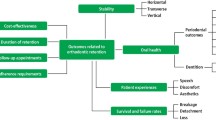Abstract
Trial design A single-centre two-arm parallel group randomised controlled trial.
Objectives To assess differences in dental stability, patient perceptions and compliance and retainer failures in adolescents treated with vacuum-formed retainers (VFR) compared with those receiving bonded canine-to canine retainers after five years in retention.
Methods In total, 104 eligible adolescents treated with fixed appliances in both jaws in a Swedish orthodontic clinic were randomised to two retention protocols. The intervention protocol consisted of a VFR covering all erupted teeth in the maxilla and a VFR in the mandible covering first premolar to first premolar. The controls received a VFR in the maxilla covering all erupted teeth and a bonded retainer wire to the lingual surfaces of the canines. The primary outcomes were various dental stability measures assessed at: debond (T1); six months (T2); 18 months (T3); and after five years (T4) in retention. Generalised estimating equations were used to quantify the effect of the different interventions on these outcome measures. One operator assessed all outcomes and participants could not be blinded. For the secondary outcomes, the perception and compliance with the retention protocols were assessed and the prevalence and rationale of retainer failure at T4. The trial was registered at ClinicalTrials.gov (NCT03070444) and the research project was supported by the Centre for Research and Development, Region Gävleborg, Sweden.
Results Of the 104 randomised patients, 30 were not available at T4, leaving 35 patients in the intervention and 39 in the comparator group. An intention-to-treat analysis was used to impute outcomes for the missing patients. Post-treatment changes at T4 were small in both jaws. In the maxilla, the Little's Irregularity Index (LII) increased similar in both retention groups (median difference: 0.3 mm). In the mandible, the median difference for the LLI in the bonded retainer group was 0.1 mm compared with 0.6 mm in VFR group. In both retention protocols, the overjet remained stable, the overbite increased and the arch lengths continued to decrease. Intercanine and intermolar width remained stable in the mandible. Intermolar width decreased significantly in the maxilla. No differences in satisfaction were found between retention protocols after five years. Also, 72% of patients had stopped or rarely wore the VFR appliances at T4. Besides some retainer failures in both groups, no serious adverse effects associated with the retainers were reported.
Conclusions Most post-treatment changes in both retention protocols were small in both jaws, except for the anterior alignment in the mandible, which was more stable in the bonded retainer group. This difference is possibly not related to the retention technique but to the poor compliance with the VFRs and the inclusion of adolescents only. Satisfaction with both protocols was similar.
This is a preview of subscription content, access via your institution
Access options
Subscribe to this journal
Receive 4 print issues and online access
$259.00 per year
only $64.75 per issue
Buy this article
- Purchase on Springer Link
- Instant access to full article PDF
Prices may be subject to local taxes which are calculated during checkout
Similar content being viewed by others
References
Krämer A, Sjöström M, Apelthun C, Hallman M, Feldmann I. Post-treatment stability after 5 years of retention with vacuum-formed and bonded retainers-a randomized controlled trial. Eur J Orthod 2022; DOI: 10.1093/ejo/cjac043.
Schulz K F, Altman D G, Moher D, CONSORT Group. CONSORT 2010 statement: updated guidelines for reporting parallel group randomized trials. Ann Intern Med 2010; 152: 726-732.
Sterne J A C, Savović J, Page M J et al. RoB 2: a revised tool for assessing risk of bias in randomised trials. BMJ 2019; DOI: 10.1136/bmj.l4898.
Lazarus C, Haneef R, Ravaud P, Boutron I. Classification and prevalence of spin in abstracts of non-randomized studies evaluating an intervention. BMC Med Res Methodol 2015; 15: 85.
Author information
Authors and Affiliations
Ethics declarations
The authors declare no conflicts of interest.
Rights and permissions
About this article
Cite this article
Steegmans, P., Cavagnetto, D. & Reynders, R. Which orthodontic retention protocol should I implement? A critical assessment of a randomised controlled trial. Evid Based Dent 23, 162–165 (2022). https://doi.org/10.1038/s41432-022-0845-7
Received:
Accepted:
Published:
Issue Date:
DOI: https://doi.org/10.1038/s41432-022-0845-7



